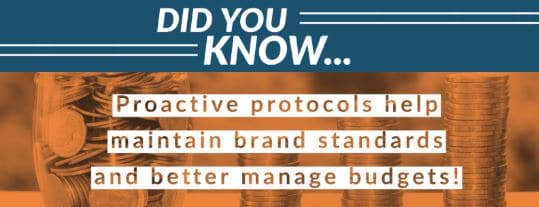Read about Proactive vs. Reactive FM Protocols in Retail & Restaurant Facility Business’s July Edition in an article written by Megan Varano, our Senior Director of Operations of Facility Maintenance.
Changing the game from reactive to proactive facility maintenance protocols.
The last decade-plus has brought tremendous change in the FM industry. It’s been thrilling to be part of the evolution. Working on both the retail and the service sides has given me a unique perspective on both the challenges and the opportunities.

Megan Varano, Powerhouse
I started out managing work requests on pieces of paper. The dispatcher would take a phone call or read an e-mail and then write out the dispatch to the field; the work request was then paperclipped to a bundle and hung on the wall. While it sounds archaic, this was in 2005!
Over the next 10 to 15 years, several work order management systems were introduced. As a service provider, these management systems obviously helped organize our vendors — but perhaps the biggest shift was for our customers. As more companies invested in CMMS systems, these investments resulted in increased visibility toward store needs, costs and execution. As our clients gained visibility and control over location expenditures, it began to drive further accountability at the vendor level. The result? The evolution of vendor score carding and, eventually, financial management / prioritization.
Now we are headed into the age of proactive vs. reactive FM. Once reserved for basic recurring needs such as HVAC PM programs, janitorial programs and exterior services, we are now evolving into proactive cosmetic repair — not only to maintain brand standard but also to better manage budgets. In this next evolution, I’ve seen and executed two options: proactive brand standard checklist implementation and proactive service bundling.
Proactive Brand Standard Checklists
Proactive brand standard checklists are typically executed by your go-to handyman. If you are lucky, he or she has been servicing your location on a recurring basis for years.
First, engage your local jack-of-all-trades with a checklist of your highest priority needs. Needs may range from lamp outages or color consistency to securing door hinges and cleaning scuff marks off walls. The idea is to engage a partner who can be set up on a recurring schedule with the intent of agreeing on a price up front for the checklist.
This can be a risk to the vendor as it is agreeing to complete the list on each service without knowing the site condition. The keys here are consistency and committing to a set duration for the program — to ensure both parties win, and that the stores are brought up to and maintain corporate brand standard.
An added benefit is forming a habit with store managers. They will know their service provider comes in on a regular basis to complete that checklist. Both parties form a relationship, and, not only are brand standards maintained, but unnecessary reactive work is prevented. Fewer reactive service dispatches also drives less office work and fewer store service disturbances.
Proactive Service Bundling
The concept of bundling is a slightly different approach. It primarily looks at reducing trips for needed items vs. proactively addressing cosmetic items not called out by the field.
First, establish a timeline during which you hold service. Essentially, you can do this in two ways: (1) Set each store on a recurring timeline window. For example, stores in X market have services bundled from Jan. 1 until Feb. 15 and those non-critical tasks are completed by Feb. 28. Market Y has services bundled from Jan. 15 to Feb. 28 and completed by March 15. This staggers the work execution for your vendors and keeps costs from hitting at the same time.
Or you can opt for a completely opposite approach: (2) Begin bundling once your first non-critical task is received. Each store will be on its own schedule, all based on when the first need is requested from the site. Hold that dispatch for a determined amount of time and during that time collect all other non-critical tasks to be dispatched in tandem. This method saves trip charges and, in most cases, it also saves labor by picking up efficiencies onsite as well as having less time spent in your stores.
The proliferation of the data from CMMS systems has enabled both concepts to be deployed. Ultimately, what our clients choose depends on what their need is. If the need is maintaining brand standard, a proactive list is best. If the need is to reduce cost and vendor time onsite, then a bundled service is better.
Both paths require a vendor that can execute and manage your approach with a technology driven solution. The market contains many options. My experience has allowed me to work with some of the best options in the industry and can speak to the efficiencies we’ve realized on the vendor side.
Planned services, while helping address your client’s driver, also enable fewer touches and overall time management of the work order. (To clarify, this can only be achieved if you have the right technology solution in place. If your provider does not have the technology to handle this, it will ultimately result in more touches and sloppy, untimely delivery of reporting.)
After weighing your options, it comes down to what’s right for your stores. Ultimately, you’ll want your stores to be your partner; the more they understand the goal, the more successful they’ll be.
Next Steps & Action Items
- Investigate what a proactive checklist would look like for you:
– Look at historical work order data to identify where most of your cosmetic money is spent. Is it loose door handles, scuffed walls or perhaps peeling wallpaper?
– Walk your proposed checklist in a handful of stores. Identify what your checklist captured and missed; modify before finalizing. I suggest having more than one set of eyes engage in this step.
- Investigate the call volume you receive per store for non-critical requests that can be handled by a handyman. Identify the average received in a given time period to identify what a good average “bundle” period would be for your stores. Don’t be afraid to modify the bundle time per market or even per store for your high revenue locations. The secondary benefit of this data pull will be its ability to provide the groundwork for your financial synopsis on the savings this could potentially drive.
- Work with a few key players on your operations team to discuss the approach that fits best.
- Make sure you have the right partner. Not only do you want to review expectations, but you want to determine if they have what it takes to deliver. Without the right technology, your vendor will be unable to deliver.
- Implement the best solution for your organization.
Click here to read Megan’s article in Retail & Restaurant’s July issue.

